‘Knowledge grows exponentially when it is shared’ – Balaji Iyer on how knowledge management has benefited Grant Thornton
This in-depth interview explains how collaboration, community, and content have helped drive business at this global audit, tax, and advisory firm.
Balaji Iyer heads the knowledge management (KM) team at Grant Thornton INDUS and is part of the GT US National Knowledge Management leadership team. He has around 17 years of experience in global knowledge and digital content delivery.
He was earlier at EY (Knowledge Operations Leader), RocSearch India (third-party knowledge services provider), and All India Radio. He also serves on the national KM committee of CII, and is an active member of the KM Global Network.
See also coverage of CII’s Global Knowledge Summit, and profiles of the Most Innovative Knowledge Enterprise (MIKE) award winners: EY, Tata Steel, Cognizant Technology Solutions, , , BINUS University (Indonesia), and (Iran).
Over the decades, KM has emerged as a powerful business enabler for global firms and scale-stage startups. Balaji joins us in this conversation on the KM journey at Grant Thornton, business impacts, emerging trends, and tips for business leaders.
Edited excerpts of the interview below:
YourStory [YS]: How would you describe the KM journey at Grant Thornton in terms of phases and achievements?
Balaji Iyer [BI]: As I think about my KM journey at Grant Thornton, ‘exciting’ and ‘rewarding’ are the two words that first come to mind.
The operative word is always going to be ‘journey.’ Looking back and connecting the dots, I see three distinct phases we have traversed thus far (KM 1.0 to KM 3.0), swiftly making inroads into the fourth phase (KM 4.0).
The big inflection point in our journey came in December 2018 as we moved away from a legacy SharePoint 2007-based intranet to Canvas — our award-winning SharePoint online-based digital workspace.
The biggest advantage of Canvas is that being on SharePoint online, it continues to evolve with the times. We were one of the first to the party as we implemented a full-fledged digital workspace based on SP Online using SharePoint Framework (SPFx).
We are now going from strength to strength. We won the Excellence in Knowledge Management award by APQC in 2019, and were the dotCOMM Gold Award winner in the Intranet Category in 2020.
Microsoft covered Grant Thornton’s digital workspace as a case study, and Doug Kalish (our Head of KM) was invited to speak about KM and Intranet journey at Microsoft’s Intrazone podcast.
We were also the global finalist for Ragan Communications’ Employee Communication Awards for our work with Rightpoint in the “Grand Prize: Best Overall Intranet” category in 2020.
While we were traversing this journey, we were agile in adapting to evolving business priorities while balancing them with our long-term vision.
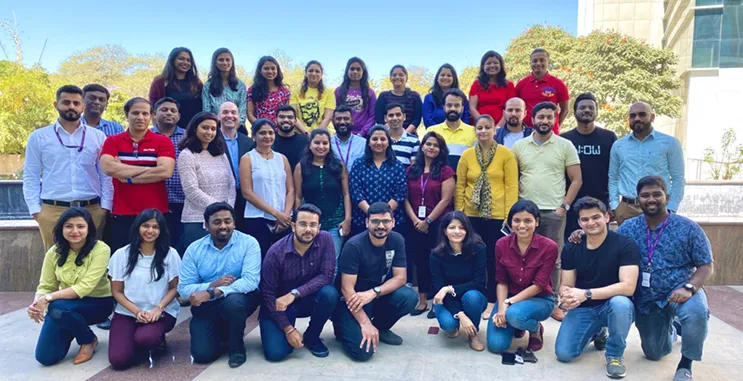
Grant Thornton KM team (Image credit: Grant Thornton)
YS: What kinds of impact has KM delivered to your business?
[BI]: KM has positively impacted both the top line and bottom line for the firm. Just a conservative estimate of the value the KM programme adds over a normative five-year period is over $50 million in revenue and savings.
Our KM programme has hit all the right notes in terms of improving speed to market and talent, vastly improving our internal efficiency play, significantly enhancing the employee experience, and driving innovation at an accelerated pace. And, we believe we are just getting started.
Canvas, our digital workplace, received close to five million visits last fiscal. A robust content discoverability via the search brings up federated results that are drawn from multiple sources — internal and external — and enhances customer engagement through the “Sell, Deliver, and Learn” cycles.
Improving top line: As an example, our tax technical research capabilities have resulted in multiple clients wins, grossing over millions of dollars. Our recently-launched knowledge product is the Tax Client Update tool (T-CUT) — a methodology that provides an automated agenda, populated with nationally reviewed technical updates for quarterly meetings with clients and prospects. It has contributed significantly to revenue generation.
Speed to market: We benefit from rapid and easy access to curated insights such as relevant case studies, lessons learnt, market intelligence, templatisation, standardisation, and thought leadership.
Over the years, through the KM programme, the firm has developed a significant body of knowledge across our key services that are now institutionalised in the form of modern online resource centres and fit-for-purpose knowledge products.
Speed to talent: Rapid staffing for new engagements is now possible based on the just in time information on existing capabilities and capacity.
Risk mitigation is enabled through automated tools that churn out ready-to-use latest regulatory guidances that are critical for professionals to deliver accurate and high-quality client service.
Efficiency play: On the ground, our holistic KM programme has reduced the time taken to complete tasks, both internal and external. This, in turn, has given the firm the ability to respond quickly to stakeholders, generate revenue, and save on cost. Hours saved on the reinvention of the ‘proverbial wheel’ now are spent on billable work and improving margins.
Enhanced employee experience: Our state-of-the-art employee private dashboard brings to life an integrated and self-managed employee experience.
Accelerated innovation and transformation: Our firm’s approach to innovation and transformation is to ‘be inclusive.’ The thriving Communities of Practice and Communities of Interests have accelerated knowledge sharing, innovation, capacity building, and speed of implementation.
For example, our low-code citizen builder community has harnessed the growing automation capabilities within the organisation. The community runs hackathons to solve real-world problems and drives rapid solution implementation.
I often say that KM is not what the KM team does; it is what the entire organisation does and something the KM team facilitates. So, the success of the KM programme at Grant Thornton (talking about the US member firm that we support) is a direct result of the firm co-opting KM principles as part of the day-to-day operations.
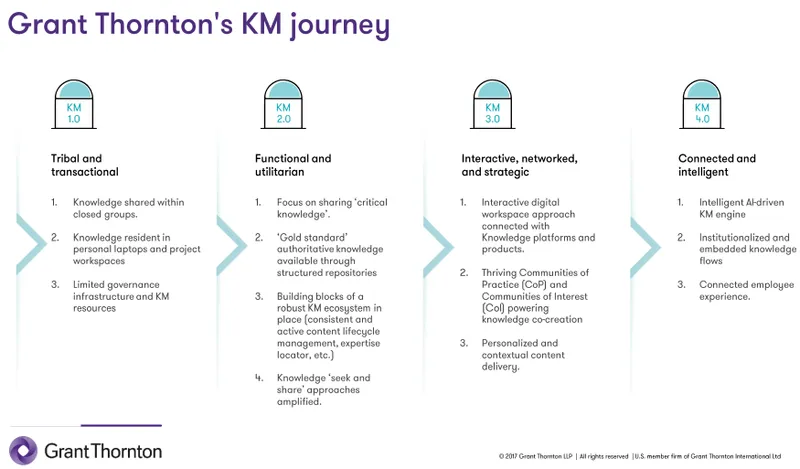
(Image credit: Grant Thornton)
YS: Can you share examples of processes where KM is embedded into the workflow, and others where it is explicit?
[BI]: A notable example of the embedded KM approach is our recently launched Engage platform — our enterprise engagement delivery platform for audit, tax, and advisory colleagues. It is simple, modern, and secure, replaces multiple legacy technologies and methodologies, and provides a consistent, firmwide experience for Grant Thornton colleagues and clients to achieve increased collaboration and results.
Knowledge and insights needed to deliver on engagements will be delivered to the point of actual consumption by connecting it to multiple firm systems, including our award-winning modern intranet Canvas.
Another worthy example is a framework the KM team co-created with the advisory team and is embedded alongside the engagement lifecycle of “Win, Plan, Kick-start, Execute, Manage and Trouble-shoot, Close, Post-closure.”
On the other hand, a popular example of where KM is explicit is the ‘Submit Content Form,’ which is ubiquitous across our firm’s modern intranet experience.
It is a super user-friendly in-take form that helps any user in the firm submit content directly to be published on our digital workplace, Canvas. With a few, simple input fields, every GT professional can share their knowledge quickly, easily, and widely.
YS: What are some of the roles and responsibilities of your KM team members?
[BI]: We have a multi-tier KM governance and delivery model that underpins our holistic and inter-disciplinary KM service model.
Core KM leadership team: We operate as an integrated KM team across the US and Bengaluru. The Head of KM is responsible for providing strategic steer and works closely with the KM leadership team (Directors, Associate Directors, and Senior Managers), who drive KM strategy and delivery of KM services within their aligned business areas.
KM service delivery teams: Our KM service delivery goes wide and deep in appropriate business areas. Our enterprise services include capabilities like enterprise content management, knowledge platforms and products, research subscription management, and change management. For each of our key service lines and functions, we have teams that provide targeted and deep KM support.
Active knowledge networks within the firm span knowledge ambassadors and stewards, office managers, and user’s voice.
Knowledge ambassadors and stewards network: We have focussed groups of colleagues who volunteer to be knowledge ambassadors and stewards from across levels in the organisation, in addition to their day job. Their focus is to build KM best practices into the work they do and represent their respective practice area from a KM perspective.
Office managers network: We have an active group of office managers (from each of the US offices) whom we support on their content management needs. They serve as our eyes and ears and change agents in each of the office locations.
User voice networks: We rely on user feedback to continue to evolve our KM ecosystem. Practitioner working group and user communities, comprising people from across departments and levels, serve as an independent user voice and helps us make decisions that are going to work for our colleagues and continue to improve the experience.
Governance layers include sponsors and advisors, who address knowledge services and content platforms.
KM sponsors: We have partner-level firm executives playing the role of KM Sponsors for each of our primary service lines and functions within the firm (such as tax, advisory, audit, growth, people, communities, etc.). The KM sponsors help set the priorities for KM services to be delivered for their respective service lines or functions and help drive desired behaviours.
Intranet Advisory Board (IAB): An active IAB — a group of senior executives in the firm — oversee and guide direction and prioritisation for internal collaboration and knowledge flow platforms and products.
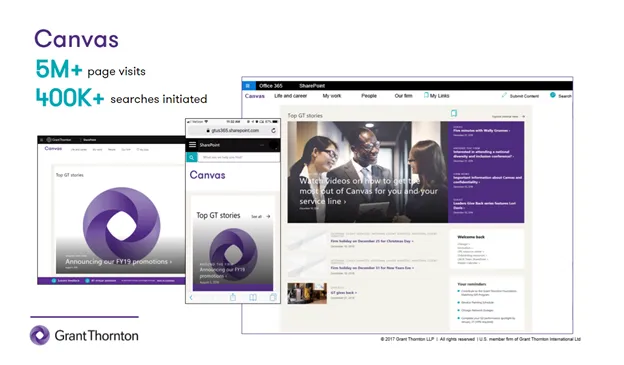
(Image credit: Grant Thornton)
YS: Can you describe some of your internal and inter-organisational communities of practice?
[BI]: Our approach to KM is big on communities – be it communities of practice or communities of interest. A few examples of successful communities of practice are described below.
Go-to-market industry communities: These are industry communities that leverage shared capabilities and institutional knowledge to increase industry focus in service lines and develop capabilities.
Talent experience programme (TEP): It is the primary career development programme for tax professionals to grow our professionals at an accelerated pace.
Campus to corporate: A campus hire development programme called Jumpstart is a readiness programme, designed to prepare professionals for the first engagement in their career.
We also have thriving communities of interest within the firm that support our colleagues to bring their whole self to work. For example, our various business resource groups — such as Equality GT (LGBTQ+ and allies), Future Leaders and allies — are communities of colleagues from various service lines, career levels, and job functions, who come together around a common interest area.
YS: What are some emerging opportunities and technologies that will impact your KM strategy?
[BI]: It is a fact that employees are trained to expect a world-class user experience as they use applications in the consumer web (designed by tech, giants, and pioneers).
So, enterprise UX often plays catch-up to the consumer web juggernaut. Our biggest opportunities will be in improving the employee experience as they interact with the knowledge infrastructure.
From a technology perspective, we anticipate AI to play a pivotal role in how knowledge is harnessed (harvested, cleansed, curated, and delivered in context). We continue to commission internal research projects and pilots to stay on top of emerging technologies and trends.
For example, one of the current research projects has focussed on employee experience products like Microsoft Viva. It could be instrumental in redefining how we preserve culture, improve connectivity for employees, disseminate learning, and harness employee resourcefulness in a hybrid work model.
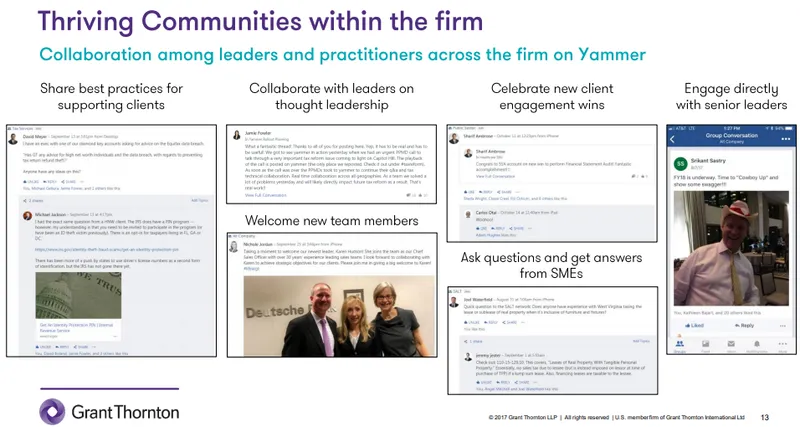
(Image credit: Grant Thornton)
YS: What are some of the next steps in your KM journey?
[BI]: As we continue our KM journey into the fourth phase (KM 4.0), we are going big on intelligent and connected employee experience.
We are closely looking into areas like anticipatory delivery of content to the point of actual consumption, hyper-personalisation using AI and data science, introducing a chatbot experience, and automating knowledge flows.
YS: What has been the impact of the COVID-19 on your KM initiatives?
[BI]: The demand for KM services and the usage of collaboration tools went up significantly as everyone started to work remote. In our experience, remote working encouraged Grant Thornton professionals to be more mindful of effective collaboration practices.
Now that people could no longer walk over to someone’s desk to ask a question or discuss a solution face to face, the same conversations quickly moved to a collaboration platform and allowed us to harness the tacit knowledge. Needless to say, our knowledge managers jumped on this opportunity.
There has been increased demand for online resource centres and knowledge products across the firm. At the same time, we have seen an increase in participation and contributions to our KM programme as people now had time (no one was commuting), and there was a felt need to increasingly rely on knowledge systems to just in time information needs.
In the words of Winston Churchill, “Never let a crisis go to waste.” We sharpened our focus on two tools during this time that helped us stay productive, connected with our people, and improved knowledge flows — Microsoft Teams for communities of practice, and Yammer, for communities of interest.

Balaji Iyer, Grant Thornton (Image credit: Grant Thornton)
YS: What are some of your tips or recommendations to other organisations on how to develop and sustain a KM strategy?
[BI]: We are now in the experience economy. Knowledge is not a game-changer anymore — it is table stakes and often the only or the main monetisable asset. So, if knowledge is not managed (well), it is mismanaged. To develop and sustain a KM strategy, my suggestion is to strive for the following principles.
Active executive buy-in: Think of knowledge as ‘latent and potent’ money (except that knowledge grows exponentially when it is shared). Business leaders would not allow people to walk away with the organisation’s money, but they will have no qualms about having people walk out with the organisation’s knowledge. Apply the same rigour to knowledge management as you apply to financial management.
Keeping KM simple and part of mandatory day-to-day workflow: Make it super easy for people to share and seek knowledge without adding to their administrative time. Also, do not make knowledge sharing and seeking optional. While making things mandatory seems like going against 'pop corporate culture,’ it is the simplest way to make things happen.
Designing incentives that drive the KM strategy forward: KM strategy will succeed only when there is a thriving knowledge sharing culture on the ground. Needless to say, you get behaviours that are incentivised.
Food for thought: Anecdotal evidence points that organisations where experts are celebrated and rewarded often show poorly on KM maturity as compared to organisations where collaboration and teamwork are incentivised.
Edited by Suman Singh




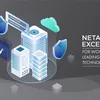
![[Year in Review 2020] Here are the Top 5 Pivot and Persist stories about startups that changed their business models amidst COVID-19](https://images.yourstory.com/cs/2/fd6b2ee0c6f411e8af1c974e95f3b2db/shutterstock1207152979-1590084243782.jpg?fm=png&auto=format&h=100&w=100&crop=entropy&fit=crop)




